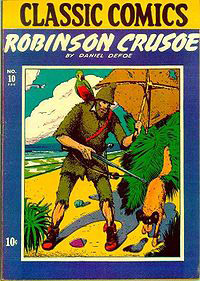Here’s the twenty second installment of LiteratEye, a series found only on The Art of the Prank Blog, by W.J. Elvin III, editor and publisher of FIONA: Mysteries & Curiosities of Literary Fraud & Folly and the LitFraud blog.
LiteratEye #22: Castaway Cuisine: How Do You Like Your Flamingo?
By W.J. Elvin III
July 17, 2009
 Back in the days of the sailing ships there were many tales of the perilous lives of castaways, some marooned – kicked off their ship on an island in the middle of nowhere — and others survivors of catastrophes. Robinson Crusoe’s story is one of the best-known castaway tales.
Back in the days of the sailing ships there were many tales of the perilous lives of castaways, some marooned – kicked off their ship on an island in the middle of nowhere — and others survivors of catastrophes. Robinson Crusoe’s story is one of the best-known castaway tales.
Crusoe first appeared without the author’s name (Daniel Defoe) and without any indication that it was a novel. A great many books of that era were first published with pious testimony as to their truth. And Crusoe is indeed based on a true story. I was researching that true story when I began wondering about castaway cuisine.
How would it go, washed up on a remote island, a thousand miles from the nearest cheeseburger? You’d probably do a quick check for cannibals or komodo dragons. And then, more than likely, begin hunting your next meal.
One foraging mariner, William Dampier, mentioned in Diana Souhemi’s book, Selkirk’s Island, gave a detailed account of the delicacies he encountered in the course of his adventures in the late 1600s.
Dampier apparently dined on most anything that moved, or so he claimed, including “monkeys, penguins, locusts.” His description of a flamingo feast could have earned him a title, “survivalist gourmet.”
Flamingo, he declared, was “very good Meat, tasting neither fishy nor in any way unsavory. Their tongues are large, having a large knob of Fat at the root, which is an excellent bit, a Dish of Flamingoes Tongues being fit for a Prince’s table.”
Do you think flamingo is really that good, or was it just that good compared to the moldy, maggoty stuff sailors had to eat on shipboard during a long voyage? I found this note on www.swashbuckler.co.nz:
“Sailors and pirates in the 18th century often ate horrible food. All the crew’s food for the entire voyage had to be packed into the hold and storerooms, and of course there was no refrigeration.”
Further research at that site and others revealed what was meant by “horrible food” – you can probably get along without the details, so let’s just say it made a flamingo sound really good.
I wondered if there might be a “Desert Island Cookbook” or something in that line.
The books or sites I found assume you’re taking your local supermarket and home kitchen along. So you get suggestions like “Joy of Cooking,” a fine old standby but it won’t tell you how to barbecue a giant Sumatran rat.
I kept digging in the weird cookbook lore.
The classic in that line is really a joke book, hardly helpful, The Original Roadkill Cookbook. It has spawned several spin-offs, as a list at Amazon illustrates.
Then there’s the Special Effects Cookbook. It’s basically science-type experiments geared toward kids and offers “safe and easy recipes for food that erupts, moves, sings, glows, talks, snaps, crackles, pops and swims.”
Do you figure Serbian chef Ljubomir Erovic’s Testicle Cookbook: Cooking with Balls is something of a prank? He claims the tastiest testicles come from bulls, ostriches, and stallions. And he offers this observation, demonstrating his commendable code of honor: “All testicles can be eaten. Except human, of course.”
On the off chance you want to venture deeper into the topic, AbeBooks top ten weird cookbooks is an interesting list. And if you keep digging, as I did, you’ll discover that “weird” morphs into “disgusting” the further you dig.
Researching the grim realities of castaway cuisine reveals that life on a desert island might be less than idyllic. Robinson Crusoe, the fictional character based on the marooned Alexander Selkirk, initially ate just about whatever he could gather, hook or shoot, though in time he was gardening and raising domesticated goats.
And then of course there was the slight problem with the culinary preferences of his newfound pal, Friday. Crusoe wasted no time converting Friday to a less threatening diet. It’s got to be a little unnerving, knowing your companion might be sizing you up as steaks and chops.
image: Wikimedia Commons
(Copyright 2009 WJE, exclusive to The Art of the Prank, for reprint rights contact Literateye@gmail.com)
Check out previous LiteratEye episodes on The Art of the Prank.
